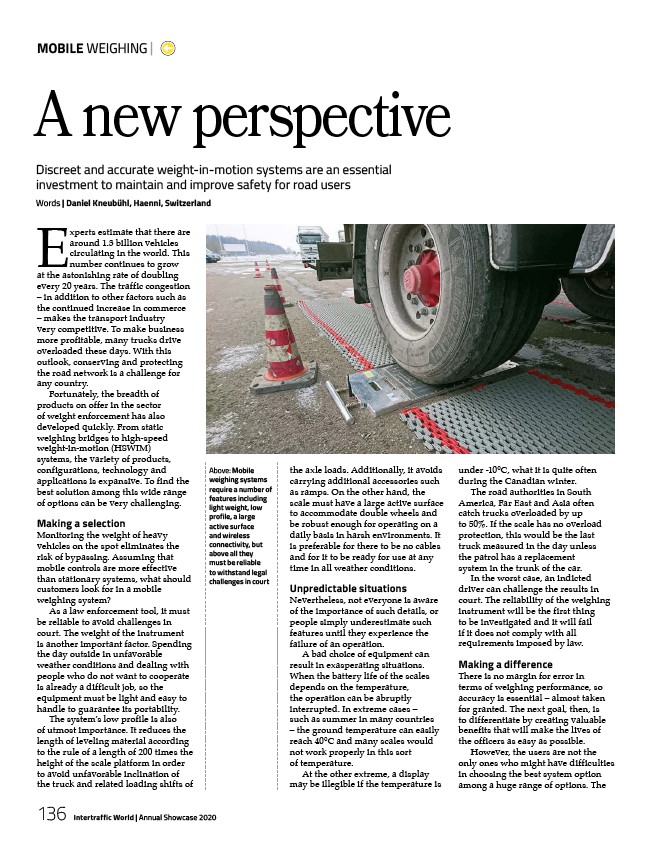
MOBILE WEIGHING |
Discreet and accurate weight-in-motion systems are an essential
investment to maintain and improve safety for road users
Words | Daniel Kneubühl, Haenni, Switzerland
Above: Mobile
weighing systems
require a number of
features including
light weight, low
profile, a large
active surface
and wireless
connectivity, but
above all they
must be reliable
to withstand legal
challenges in court
Experts estimate that there are
around 1.3 billion vehicles
circulating in the world. This
number continues to grow
at the astonishing rate of doubling
every 20 years. The traffic congestion
– in addition to other factors such as
the continued increase in commerce
– makes the transport industry
very competitive. To make business
more profitable, many trucks drive
overloaded these days. With this
outlook, conserving and protecting
the road network is a challenge for
any country.
Fortunately, the breadth of
products on offer in the sector
of weight enforcement has also
developed quickly. From static
weighing bridges to high-speed
weight-in-motion (HSWIM)
systems, the variety of products,
configurations, technology and
applications is expansive. To find the
best solution among this wide range
of options can be very challenging.
Making a selection
Monitoring the weight of heavy
vehicles on the spot eliminates the
risk of bypassing. Assuming that
mobile controls are more effective
than stationary systems, what should
customers look for in a mobile
weighing system?
As a law enforcement tool, it must
be reliable to avoid challenges in
court. The weight of the instrument
is another important factor. Spending
the day outside in unfavorable
weather conditions and dealing with
people who do not want to cooperate
is already a difficult job, so the
equipment must be light and easy to
handle to guarantee its portability.
The system’s low profile is also
of utmost importance. It reduces the
length of leveling material according
to the rule of a length of 200 times the
height of the scale platform in order
to avoid unfavorable inclination of
the truck and related loading shifts of
136 Intertraffic World | Annual Showcase 2020
the axle loads. Additionally, it avoids
carrying additional accessories such
as ramps. On the other hand, the
scale must have a large active surface
to accommodate double wheels and
be robust enough for operating on a
daily basis in harsh environments. It
is preferable for there to be no cables
and for it to be ready for use at any
time in all weather conditions.
Unpredictable situations
Nevertheless, not everyone is aware
of the importance of such details, or
people simply underestimate such
features until they experience the
failure of an operation.
A bad choice of equipment can
result in exasperating situations.
When the battery life of the scales
depends on the temperature,
the operation can be abruptly
interrupted. In extreme cases –
such as summer in many countries
– the ground temperature can easily
reach 40°C and many scales would
not work properly in this sort
of temperature.
At the other extreme, a display
may be illegible if the temperature is
under -10°C, what it is quite often
during the Canadian winter.
The road authorities in South
America, Far East and Asia often
catch trucks overloaded by up
to 50%. If the scale has no overload
protection, this would be the last
truck measured in the day unless
the patrol has a replacement
system in the trunk of the car.
In the worst case, an indicted
driver can challenge the results in
court. The reliability of the weighing
instrument will be the first thing
to be investigated and it will fail
if it does not comply with all
requirements imposed by law.
Making a difference
There is no margin for error in
terms of weighing performance, so
accuracy is essential – almost taken
for granted. The next goal, then, is
to differentiate by creating valuable
benefits that will make the lives of
the officers as easy as possible.
However, the users are not the
only ones who might have difficulties
in choosing the best system option
among a huge range of options. The
A new perspective